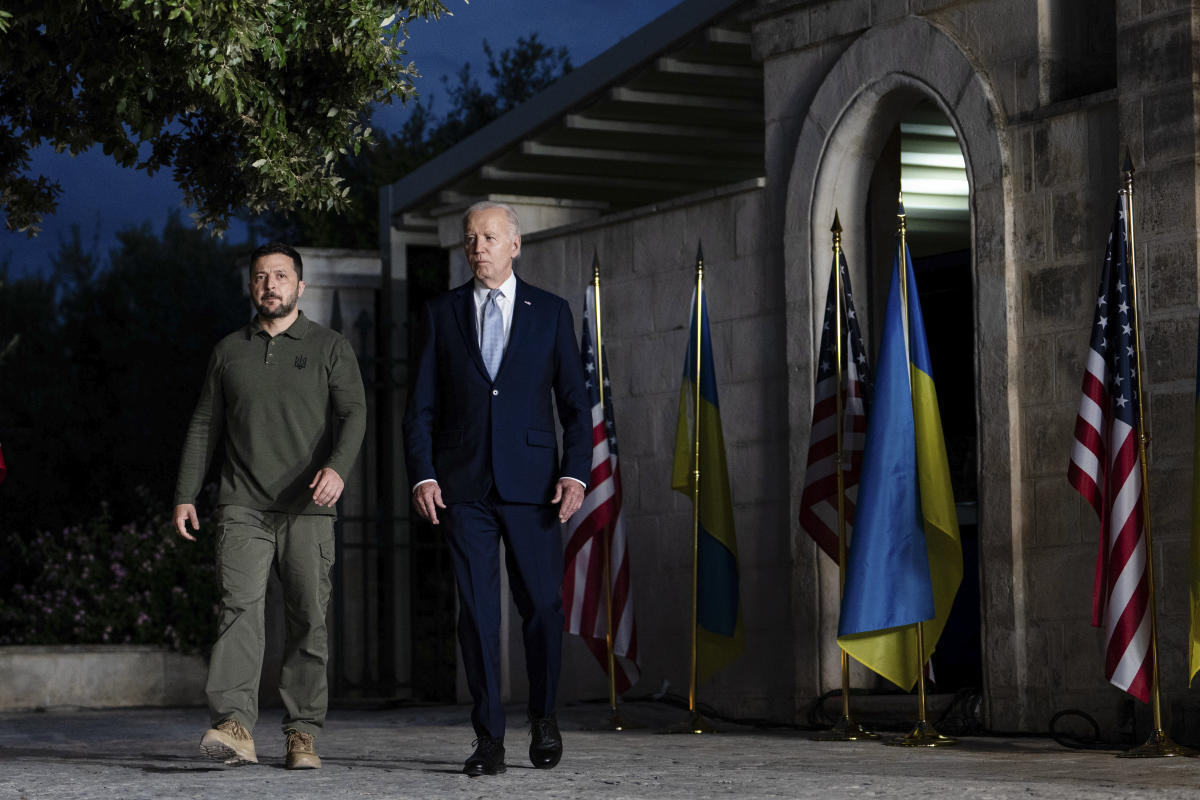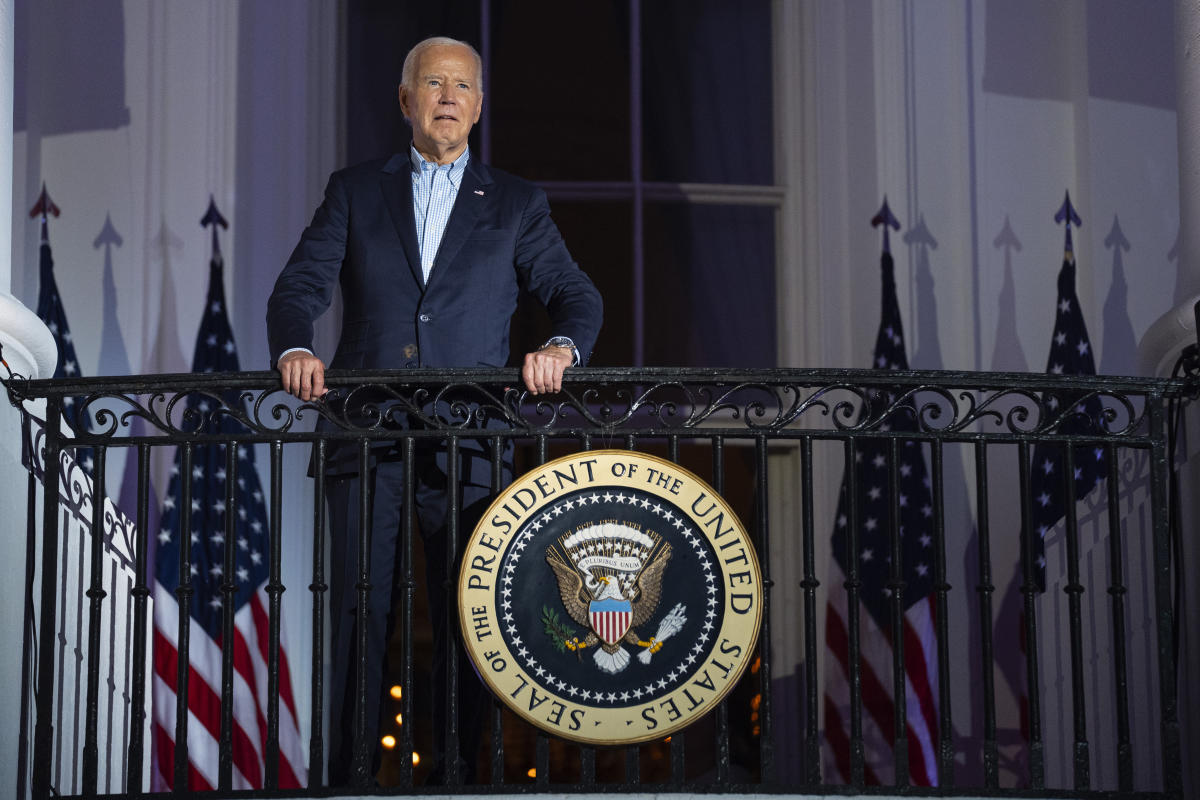BARI, Italy — U.S. President Joe Biden has consistently resisted pressure throughout the 27 months of war to admit Ukraine to NATO, believing it could quickly lead to U.S. forces in direct conflict with the Russians would be sent.
So he introduced alternative steps on Thursday to show Russian President Vladimir Putin that the United States and its allies were not about to pack up and leave.
Sign up for The Morning newsletter from the New York Times
Biden signed a ten-year security treaty with the Ukrainian president Volodymyr Zelensky which Biden portrayed as guaranteeing the supply of weapons, intelligence support, advice and technology needed to win the war and deter another one.
He also said the United States would take the lead in providing a $50 billion loan to Ukraine to rebuild destroyed ports and power plants and buy weapons. The money is to be repaid from the interest generated from $300 billion in assets that Putin, inexplicably, left behind in Western financial institutions before his invasion in February 2022.
“Our goal is to strengthen Ukraine’s long-term credible defense and deterrence capabilities,” Biden said moments after he and Zelenskyy signed the deal on Italy’s southwest coast, where the Group of Seven industrialized nations opened their annual leaders’ conference.
“We will not give in,” he added, warning Putin that “he cannot wait for us.”
Zelenskyy thanked Biden warmly, even though the security pact and loan fell far short of what he wanted at this serious moment in the war. Zelensky has made no secret of the difficulty of focusing on Ukraine’s long-term prospects while desperately concerned about its short-term survival in the face of relentless, if incremental, Russian progress.
But the bigger concern for Ukraine’s increasingly embattled leader and Europe as a whole is that the accords themselves may not survive the outcome of the U.S. and Europe’s elections.
The security pact, based on similar decade-long commitments to Israel, includes no funding — only a U.S. commitment to work with Congress to secure the tens of billions of dollars that would be needed. That likely means another nail-biting battle on Capitol Hill, where a narrow majority of Republicans in Congress had resisted for months more commitments of funding and the weapons they buy before the funding was approved in April.
But the bigger concern for Zelenskyy is that Biden, with whom his relationship has often been controversial, may be at his last G7 summit. And hidden in the fine print of the security agreement they signed with flair is this paragraph: “Either Party may terminate this Agreement by written notice through diplomatic channels” which “would become effective six months later.”
That’s exactly the kind of loophole that former US President Donald Trump exploited with the Iran nuclear deal, which he left in 2018. Trump has made no secret of his disdain for Ukraine or his desire to relieve the United States of a huge financial obligation there. . Instead, he has insisted he could end the war within 24 hours – presumably by telling Putin he can keep the territory he has already seized.
“It’s an agreement that really captures the moment,” said Seth G. Jones, director of the Transnational Threats Project at the Center for Strategic and International Studies, a leading research institute in Washington, who just returned from a visit to Ukraine. “On the one hand, it is a useful step to build a long-term relationship with Ukraine. On the other hand, it is much less in line with what the Ukrainians really want: a real NATO membership, which, unlike the piece of paper that both men signed with such flair, is difficult to revoke.
If the $50 billion loan is disbursed this year, it will be harder for a future president to reverse. And the money comes just in time: Ukraine’s budget situation is so dire that the country has been forced to sell a number of state assets.
U.S. Treasury Secretary Janet Yellen, an architect of the loan plan that leaves Russia’s principal untouched but uses the interest it earns, said at an event in New York on Thursday that it showed Putin that Ukraine’s allies are “fully united” ” goods.
“We intend to provide Ukraine with the resources it needs to wage an effective war against Russia and support their immediate budgetary needs, and we are going to provide a very meaningful share of the resources,” she said.
“This is the first tranche, and there is more behind it if necessary,” Yellen said. “In a sense, we are making Russia help pay for the damage it has caused.”
European Commission President Ursula von der Leyen said on Thursday that all members of the G7 countries would participate in the loan, and that the European Union could contribute up to half of the money, a senior European official said. The US would make up the difference.
But the loan is a race against time and Russia’s destructive capabilities.
During the first two years of the war, it was believed that time was on Ukraine’s side and that Putin would have to withdraw if the war lasted too long. Now no one is so sure that this is still the case.
Until recent days, the Russians appeared to have the momentum for months — though they have now slowed after Biden, backtracking, allowed Ukraine to fire U.S.-supplied weapons at the Russian side of the border near the northeastern city of Kharkiv. Biden and his aides called it a “common sense” move, denying Putin the chance to attack Ukraine without fear of retaliation.
The reversal also stemmed from fear that the Ukrainian leader was running out of options. He is clearly short on troops and air defense. He may not have much time.
Ukraine’s current precarious position differs markedly from that of a few months after the war in 2022, when it seemed as if the Russian military was on the verge of collapse. In 2023, there was hope that a Ukrainian ‘counter-offensive’ would push Russian forces out of the country. It flopped.
On Thursday, for all the talk about continuing the war “as long as it lasts,” there was little discussion, at least within earshot of reporters, about what a realistic endgame might look like. The new security agreement refers to a “just and lasting peace” without defining what that means – or what happens when a just peace is at odds with a lasting peace.
Putin also appears to have a remarkably high tolerance for pain – or at least for the suffering of his troops.
On average, more than a thousand Russian soldiers were killed or wounded every day in May, senior military officials from NATO and the West said Thursday. Ukraine’s armed forces are stepping up offensive operations as more Western military aid finally reaches the battlefield after months of delays.
A Western military official said that the Russian attack on Kharkov has reached its peak and is not expected to continue in the near future, and that Ukrainian attacks on artillery bases in Russia are beginning to worsen their attacks.
But a senior NATO official, delivering an assessment at a briefing, said Russia is expected to “make a pretty big push” in the coming weeks in what is likely to be a bloody rebuttal to Ukraine’s newfound military capabilities. And Russia, the official said, would like nothing more than to spoil NATO’s 75th anniversary celebrations in Washington next month.
“None of us should be under the illusion that this is going to be an easy summer,” the official said.
Only after surviving that, and the upcoming elections, will Biden and Zelenskyy be able to think together about what Ukraine’s long-term future might look like. Otherwise, all bets are off, including how long the partnership they agreed to on Thursday will actually last.
c.2024 The New York Times Company







